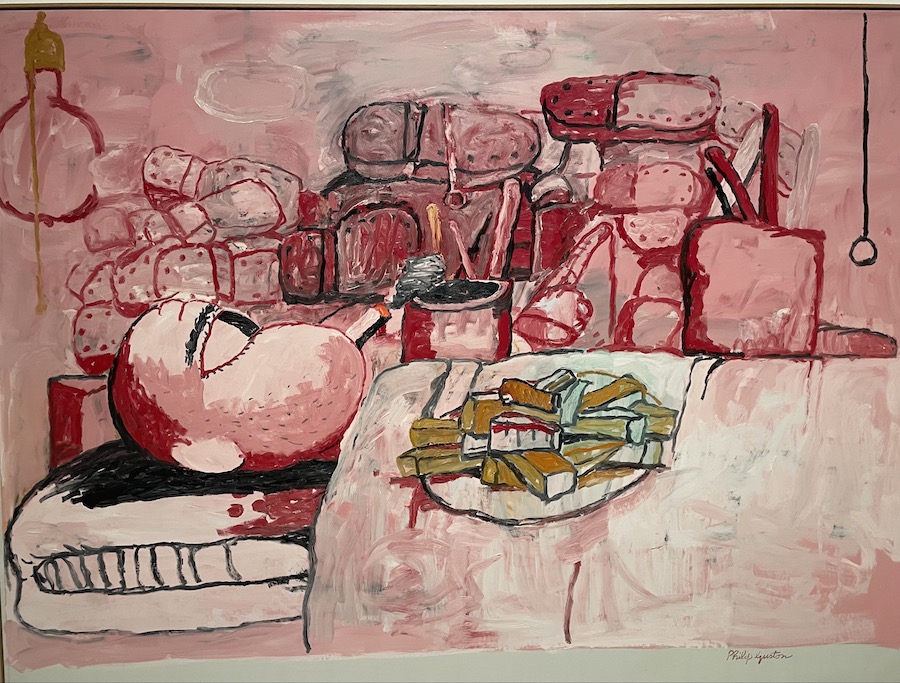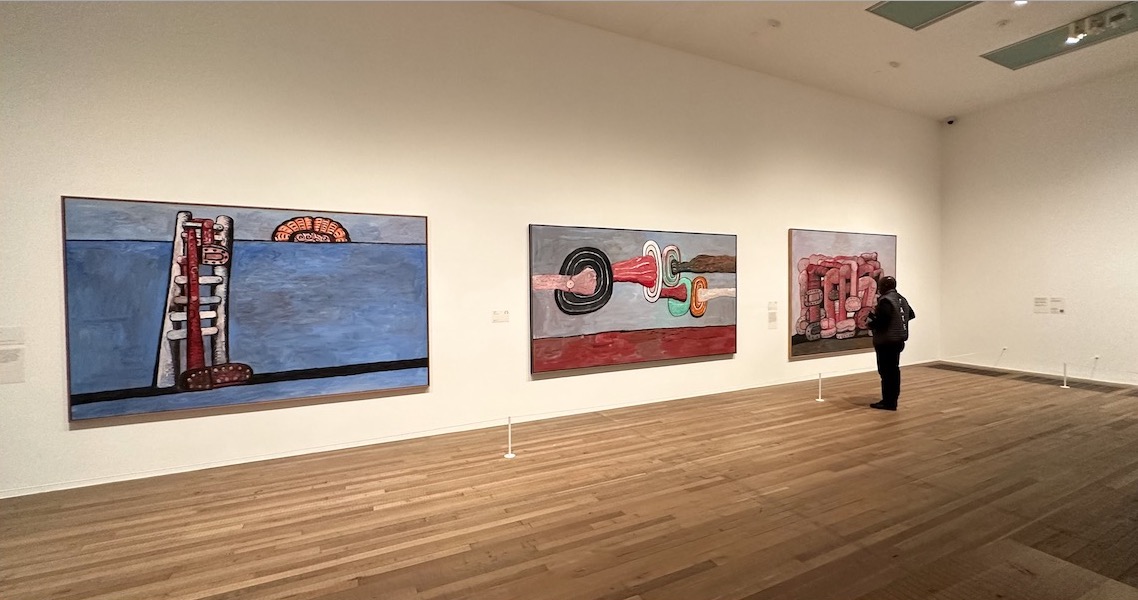If you see only one show in London this autumn, then go to see the much-postponed Philip Guston at Tate Modern. After the George Floyd murder in 2020, many art institutions in the US got cold feet about his depiction of Ku Klux Klansmen, perhaps fearing that many Americans are unable to recognise irony and would see them as an advertisement for the Klan rather than as a savage critique. But this powerful exhibition shows that his hood paintings, even when tinged with humour, are a ferocious attack on white supremacy and all things fascist. Klansmen ride in goofy cars, holding cigarettes in their fat, pink sausage fingers- both figures of fun and fear. Though painted in the middle of the last century, they could not be more relevant to our dystopian times.
Guston challenges us to ask difficult questions: why are we here? What’s our point and purpose, what constitutes morality, and what makes us human?
It has been said that what is overwhelming and unnameable is often handed down over the generations, what we cannot bear, bequeathed to those who follow us. Philip Guston liked to tell people that his family came from Odessa. In fact, his parents probably came from Poland. But Odessa may have stood in his mind for all those lesser-known parts of Eastern Europe where Jews were being persecuted at the beginning of the last century. Almost penniless, his father, Leib, set sail in steerage for Montreal in 1905, followed by his mother with their four children. The family settled in an impoverished Jewish quarter of the city. Philip Goldstein, their seventh child, was born in 1913. It would not be until 1937 that he’d use the name Guston. In Montreal, his mother, Rachel, kept kosher and sent the children to religious school, but his remote and depressed father objected to this religious education. In 1922, the family moved to Los Angeles. In Canada, Leib had worked as a boilermaker for the Canadian Pacific Railway, but now, in Los Angeles, he was reduced to being a ragpicker. Devitalised and angry, he would, in 1923, hang himself when Philip was only ten. Rachel claimed to have discovered him hanging from a rope on the porch. Though, later, her son would profess to have found him. Whatever the truth, the trauma, along with the family’s escape from the dangers of those Eastern European pogroms, would sear themselves deep into the psyche of the young Philip to re-emerge as some of the most potent paintings of the late 20th century.

In 1935, he travelled to Mexico and met the great Mexican muralists, Diego Rivera and David Siqueiros, going on to paint his own tondo of Guernica. Despite being a keen cartoonist at school, the surrealist-inspired early paintings from the 1930s show a prodigious painterly talent. But such work was not in tune with the post-war times, unsympathetic to figuration. Subsequent experiments with abstraction won him a place in the New York school of the 1950s, alongside Rothko and his old school buddy Jackson Pollock. Pulsars of thick paint throb in the middle of his canvases as if about to explode with energy. But in the ‘60s, he came to feel that “there is something ridiculous and miserly in the myth we inherit from abstract art. That painting is autonomous, pure and for itself.”
So, going against the aesthetic shibboleths that made others heroes of American abstraction, he returned to figuration after more than a decade. His lexicon of cartoonish images would remain with him for the rest of his life. Perhaps he simply felt that what he had to say was too urgent, too raw and too painful for the inherent aesthetic purity of abstraction. Wracked with existential doubt, his imagination filled with the suffering of the death camps, his powerful paintings are entirely unlike any others of the period. Both an angry roar and a desperate whimper. It’s as if Giacometti and Sam Beckett had joined forces with Disney’s Goofy. Appropriating objects from the world around him – what he called crapola – trashcans, ashtrays, cigarettes – all become signifiers of angst and self-doubt in his hands. Over and over again, he asks: what would it be like to be evil? What separates me/us from those hooded Klansmen who ride around in their flash cars smoking big cigars, killing and terrorising? It’s as if humour and the cartoon allowed him to say what was unsayable so that the observer wouldn’t run away. Much affected by the Vietnam War of the 1960s, he endlessly worried: ”What kind of man am I, sitting at home…going into frustrated fury about everything then going into my studio to adjust a red to a blue?”.
Elbows, watches, and ashtrays litter his paintings. His props are the objects of everyday life. Though it’s impossible not to see his stubby ladders as a bid for freedom or the piles of discarded hobnail boots as a reference to the mountains of shoes abandoned by those destined for the gas chambers or the tangle of red legs as the twisted limbs of the corpses piled high at Auschwitz.
But it’s the last room at Tate Modern that makes the heart skip a beat. There, lying in bed on his side, his knees drawn up under him, one eye visible, its spider-like lashes splayed out on the red cover, his top lid appears to be sewn shut with a row of black stitches as if the world is just too unbearable to look at directly. In Couple in Bed, he’s curled up next to his wife, the poet Musa McKim, who has just suffered three debilitating strokes. His bony red shoulder pokes pathetically above the bedclothes as he clutches a bouquet of paintbrushes in one hand whilst desperately clinging to her with the other. It’s as if he is saying, in this poignant, tender painting, this is all I have: my wife and painting. Without them, I am nothing. Over and over, as you walk around the exhibition, he challenges us to ask difficult questions: why are we here? What’s our point and purpose, what constitutes morality, and what makes us human? In front of his unflinching images, he dares us to stand and look, not to blink and turn away.
Philip Guston, Tate Modern 5 October 2023 – 25 February 2024, £20, Free For Members
Visit Here
Photos: ©Artlyst 2023
Sue Hubbard is an award-winning poet, novelist and freelance art critic. Her latest novel, Flatlands from Pushkin Press, can be ordered here
Her latest collection of poetry, God’s Little Artist: poems on the Life of Gwen John, can be ordered here:

